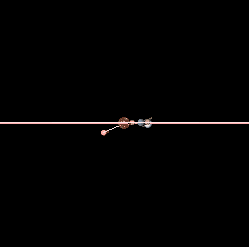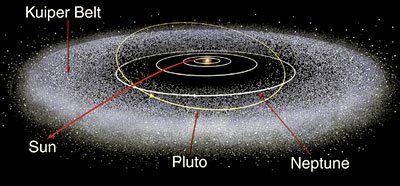Orbit
Pluto's orbital period is 248 years. Its orbital characteristics are substantially different from those of the planets, which follow nearly circular orbits around the Sun close to a flat reference plane called the ecliptic. In contrast, Pluto's orbit is moderately inclined relative to the ecliptic (over 17°) and moderately eccentric (elliptical). This eccentricity means a small region of Pluto's orbit lies nearer the Sun than Neptune's. The Pluto–Charon barycenter came to perihelion on , and was last closer to the Sun than Neptune between , and .

Orbit of Pluto—ecliptic view. This side view of Pluto's orbit (in red) shows its large inclination to the ecliptic.
In the long term, Pluto's orbit is chaotic. Although computer simulations can be used to predict its position for several million years (both forward and backward in time), after intervals longer than the Lyapunov time of 10–20 million years, calculations become speculative: Pluto is sensitive to immeasurably small details of th Solar System, hard-to-predict factors that will gradually change Pluto's position in its orbit.
Relationship with Neptune
Despite Pluto's orbit appearing to cross that of Neptune when viewed from directly above, the two objects' orbits are aligned so that they can never collide or even approach closely. There are several reasons why.
At the simplest level, one can examine the two orbits and see that they do not intersect. When Pluto is closest to the Sun, and hence closest to Neptune's orbit as viewed from above, it is also the farthest above Neptune's path. Pluto's orbit passes about 8 AU above that of Neptune, preventing a collision. Pluto's ascending and descending nodes, the points at which its orbit crosses the ecliptic, are currently separated from Neptune's by over 21°.

Orbit of Pluto—the Kuiper Belt.
This alone is not enough to protect Pluto; perturbations from the planets (especially Neptune) could alter aspects of Pluto's orbit (such as its orbital precession) over millions of years so that a collision could be possible. Some other mechanism or mechanisms must therefore be at work. The most significant of these is that Pluto lies in the 2:3 mean-motion resonance with Neptune: for every two orbits that Pluto makes around the Sun, Neptune makes three. The two objects then return to their initial positions and the cycle repeats, each cycle lasting about 500 years. This pattern is such that, in each 500-year cycle, the first time Pluto is near perihelion, Neptune is over 50° behind Pluto. By Pluto's second perihelion, Neptune will have completed a further one and a half of its own orbits, and so will be a similar distance ahead of Pluto. Pluto and Neptune's minimum separation is over 17 AU, which is greater than Pluto's minimum separation from Uranus (11 AU).
The 2:3 resonance between the two bodies is highly stable, and is preserved over millions of years. This prevents their orbits from changing relative to one another; the cycle always repeats in the same way, and so the two bodies can never pass near each other. Thus, even if Pluto's orbit were not inclined, the two bodies could never collide.